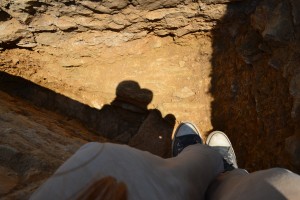I spent this final week of the dig the same way I spent the three days previously: articulating walls and other various forms of essentially cleaning up the area known as structure IV. This building encompasses both trenches 4 and 5, which I bounced between as was necessary to be useful. At this point, we still don’t really know what it was, but I’m thinking a house that may have also had some sort of manufacturing facility because it has two rooms with plenty of storage in both trenches (so we think, including the bothros) and possible metallic slag spillage over into trench 3. On Wednesday, we also spent a lot of time preparing for next year. I think there’s a great set up on the Acropolis for next year, and hopefully whoever comes next to excavate it. I wonder if there’s actually a church up there.
Here are my final thoughts:
This month I learned how to articulate walls, distinguish pottery from the rocks around it, and properly excavate a trench. I also realized how much we actually know, which isn’t always very much. Let’s take my lovely pit for example. All the experts thought I had hit bedrock last week. However, it went so much deeper than that, and split into 3 different zones. And we didn’t even hit bedrock but found the foundations instead. In essence, no matter what theories we have, we can always be very wrong about them, and history throws us for a loop, as we try to figure out what actually happened. In addition I learned about the true joy of throwing rocks off of large hills. My most memorable experience here was working in the pit. I spent the preponderance of my time there, and I’ll probably not forget about how people always commented about how they couldn’t see me working from down there. This project changed some of my perspectives on things. For instance, I didn’t know how humid South Turkey could be. I had thought it would be a dry heat, like everywhere else in the Mediterranean. I also didn’t realize that some of the pots we see in museums had to be reconstructed from the sherds archaeologists had to find in the soil. The weight of what I did there hasn’t hit me yet. This thought isn’t saying that what I did was unimportant, but I still don’t know how large of an impact my work made for the site or Turkey as whole. But I did get a more proper perspective on the work an archaeologist does.
My advice for interested students would be to bring benadryl gel (because bugs are everywhere), detergent, and a ton of flexibility because you may switch from place to place, but these changes cannot affect your work. Additionally, I would tell people interested in going only to expect finding something, because I think that allows a certain flexibility and prevents disappointment. They should also expect to learn quite a bit about archaeology. And I would totally do another dig, because it’s joining in with history and restoring stories to people long gone. Though I personally may want to go somewhere else, because I’m interested in ancient history outside of the Mediterranean (because that’s what we’re told the most about). But returning to Antiochia at some point would be a lot of fun and another great research opportunity, too.
Picture- my feet dangling over the final stage of the pit. It’s so deep.

You must be logged in to post a comment.